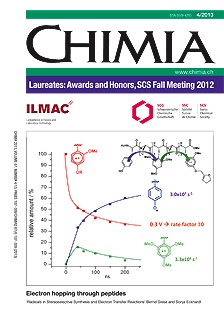Practical Considerations for Improving the Productivity of Mass Spectrometry-based Proteomics
DOI:
https://doi.org/10.2533/chimia.2013.244Keywords:
Electron transfer dissociation (etd), Higher-energy collisional dissociation (hcd), Limited proteolysis, Middle-down proteomics, Post-column superchargingAbstract
Mass spectrometry (MS) is currently the most sensitive and selective analytical technique for routine peptide and protein structure analysis. Top-down proteomics is based on tandem mass spectrometry (MS/MS) of intact proteins, where multiply charged precursor ions are fragmented in the gas phase, typically by electron transfer or electron capture dissociation, to yield sequence-specific fragment ions. This approach is primarily used for the study of protein isoforms, including localization of post-translational modifications and identification of splice variants. Bottom-up proteomics is utilized for routine high-throughput protein identification and quantitation from complex biological samples. The proteins are first enzymatically digested into small (usually less than ca. 3 kDa) peptides, these are identified by MS or MS/MS, usually employing collisional activation techniques. To overcome the limitations of these approaches while combining their benefits, middle-down proteomics has recently emerged. Here, the proteins are digested into long (3–15 kDa) peptides via restricted proteolysis followed by the MS/MS analysis of the obtained digest. With advancements of high-resolution MS and allied techniques, routine implementation of the middle-down approach has been made possible. Herein, we present the liquid chromatography (LC)-MS/MS-based experimental design of our middle-down proteomic workflow coupled with post-LC supercharging.Downloads
Published
2013-04-24
Issue
Section
Scientific Articles
License
Copyright (c) 2013 Swiss Chemical Society

This work is licensed under a Creative Commons Attribution-NonCommercial 4.0 International License.
How to Cite
[1]
Ünige A. Laskay, K. Srzentić, L. Fornelli, O. Upir, A. N. Kozhinov, M. Monod, Y. O. Tsybin, Chimia 2013, 67, 244, DOI: 10.2533/chimia.2013.244.







